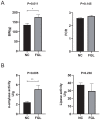Genome-Wide and 16S rRNA Sequencing-Based Analysis on the Health Effects of Lacticaseibacillus paracasei XLK401 on Chicks
- PMID: 37763985
- PMCID: PMC10538037
- DOI: 10.3390/microorganisms11092140
Genome-Wide and 16S rRNA Sequencing-Based Analysis on the Health Effects of Lacticaseibacillus paracasei XLK401 on Chicks
Abstract
Lacticaseibacillus paracasei, serves as a growth promoter used in the poultry industry, contributeing to broiler development. However, practical studies are needed to determine the probiotic potential and growth-promoting effects of specific L. paracasei strains. This study aims to determine whether L. paracasei XLK401 influences broiler chicken growth and the mechanisms involved. Notably, we identified several bile salt and acid tolerance-related genes (Asp23, atpD, atpA, atpH, and atpF) in L. paracasei XLK401. This bacterium demonstrates robust probiotic properties under acidic conditions (pH 2.0) and 0.3% bile salt conditions. It also contains a variety of antioxidant-related genes (trxA, trxB, and tpx), carbohydrate-related genes, gene-encoding glycosidases (e.g., GH and GT), and three clusters of genes associated with antimicrobial compounds. Supplementation with L. paracasei XLK401 significantly increased the body weight of the chicks. In addition, it significantly increased hepatic antioxidant enzyme activities (GSH-Px, SOD, and T-AOC) while significantly decreasing the levels of oxidative damage factors and inflammatory factors (MDA and IL-6), resulting in improved chick health. Improvements in body weight and health status were associated with significant increases in α-amylase activity and the remodeling of the host gut microbiota by L. paracasei XLK401. Among them, actinobacteria abundance in chicken intestines after feeding them L. paracasei XLK401 was significantly decreased, Bifidobacterium sp. abundance was also significantly decreased, and Subdoligranulum sp. abundance was significantly increased. This suggests that L. paracasei XLK401 can regulate the abundance of certain bacteria without changing the overall microbial structure. In addition, in the correlation analysis, Subdoligranulums sp. were positively correlated with SOD and negatively correlated with IL-1β and MDA. Overall, our study demonstrates that L. paracasei XLK401 effectively promotes healthy chick growth. This is made possible by the modulation of gut microbe abundance and the underlying probiotic effect of L. paracasei XLK401. Based on these findings, we postulate L. paracasei XLK401 as a potential efficient growth promoter in broiler farming.
Keywords: 16S; Lacticaseibacillus paracasei; genome-wide; growth promoter; probiotic potential.
Conflict of interest statement
The authors declare no competing interests.
Figures







Similar articles
-
Genomic Insight Into Lacticaseibacillus paracasei SP5, Reveals Genes and Gene Clusters of Probiotic Interest and Biotechnological Potential.Front Microbiol. 2022 Jun 16;13:922689. doi: 10.3389/fmicb.2022.922689. eCollection 2022. Front Microbiol. 2022. PMID: 35783439 Free PMC article.
-
Genomic insights and functional evaluation of Lacticaseibacillus paracasei EG005: a promising probiotic with enhanced antioxidant activity.Front Microbiol. 2024 Oct 14;15:1477152. doi: 10.3389/fmicb.2024.1477152. eCollection 2024. Front Microbiol. 2024. PMID: 39469458 Free PMC article.
-
Gut microbial change after administration of Lacticaseibacillus paracasei AO356 is associated with anti-obesity in a mouse model.Front Endocrinol (Lausanne). 2023 Aug 29;14:1224636. doi: 10.3389/fendo.2023.1224636. eCollection 2023. Front Endocrinol (Lausanne). 2023. PMID: 37705572 Free PMC article.
-
Lacticaseibacillus paracasei LB12, a Potential Probiotic Isolated from Traditional Iranian Fermented Milk (Doogh).Curr Microbiol. 2023 Sep 2;80(10):333. doi: 10.1007/s00284-023-03376-z. Curr Microbiol. 2023. PMID: 37658854 Review.
-
Health-Promoting Properties of Lacticaseibacillus paracasei: A Focus on Kefir Isolates and Exopolysaccharide-Producing Strains.Foods. 2021 Sep 22;10(10):2239. doi: 10.3390/foods10102239. Foods. 2021. PMID: 34681288 Free PMC article. Review.
Cited by
-
Effect of Lactobacillus paracasei LK01 on Growth Performance, Antioxidant Capacity, Immunity, Intestinal Health, and Serum Biochemical Indices in Broilers.Animals (Basel). 2024 Dec 1;14(23):3474. doi: 10.3390/ani14233474. Animals (Basel). 2024. PMID: 39682439 Free PMC article.
-
Potency of Lacticaseibacillus paracasei as an alternative to antibiotic growth promoter in broiler chicken challenged with avian pathogenic Escherichia coli.Vet World. 2025 May;18(5):1180-1189. doi: 10.14202/vetworld.2025.1180-1189. Epub 2025 May 17. Vet World. 2025. PMID: 40584125 Free PMC article.
-
Inoculation with Lentilactobacillus buchneri alone or in combination with Lentilactobacillus hilgardii modifies gene expression, fermentation profile, and starch digestibility in high-moisture corn.Front Microbiol. 2023 Oct 12;14:1253588. doi: 10.3389/fmicb.2023.1253588. eCollection 2023. Front Microbiol. 2023. PMID: 37901805 Free PMC article.
-
Evaluating Good Husbandry Practices and Organic Fermented Additives for Coccidiosis Control in a Pilot Study Using Slow-Growing Broilers.Animals (Basel). 2025 Jun 13;15(12):1752. doi: 10.3390/ani15121752. Animals (Basel). 2025. PMID: 40564305 Free PMC article.
References
-
- Serratosa J., Blass A., Rigau B., Mongrell B., Rigau T., Tortades M., Tolosa E., Aguilar C., Ribo O., Balague J. Residues from veterinary medicinal prodects, growth promoters and performance enhancers in food-producing animals: A European Union perspective. Rev. Sci. Tech. Off. Int. Epizoot. 2006;25:637–653. doi: 10.20506/rst.25.2.1687. - DOI - PubMed
-
- Sopkova D., Hertelyova Z., Andrejcakova Z., Vlckova R., Gancarcikova S., Petrilla V., Ondrasovicova S., Kresakova L. The application of probiotics and flaxseed promotes metabolism of n-3 polyunsaturated fatty acids in pigs. J. Appl. Anim. Res. 2017;45:93–98. doi: 10.1080/09712119.2015.1124333. - DOI
-
- Ke X.L., Liu Z.G., Zhang M.Y., Zhu W.J., Yi M.M., Cao J.M., Gao F.Y., Wang M., Lu M.X. A bacillus cereus NY5 strain from tilapia intestine antagonizes pathogenic streptococcus agalactiae growth and adhesion in vitro and in vivo. Aquaculture. 2022;561:738729. doi: 10.1016/j.aquaculture.2022.738729. - DOI
Grants and funding
LinkOut - more resources
Full Text Sources
Miscellaneous

